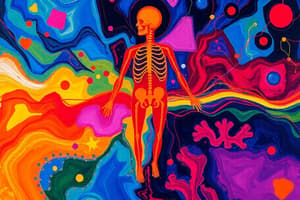Podcast
Questions and Answers
Which of the following is NOT a physiological variable that is regulated by homeostasis?
Which of the following is NOT a physiological variable that is regulated by homeostasis?
- Blood pressure (correct)
- Blood pH
- Blood volume
- Blood sugar
What type of tissue is responsible for carrying nerve impulses throughout the body?
What type of tissue is responsible for carrying nerve impulses throughout the body?
- Muscle tissue
- Epithelial tissue
- Nervous tissue (correct)
- Connective tissue
Which of the following is an example of a negative feedback loop in maintaining blood glucose levels?
Which of the following is an example of a negative feedback loop in maintaining blood glucose levels?
- When blood glucose levels are low, the pancreas releases glucagon, which decreases blood glucose levels.
- When blood glucose levels are high, the pancreas releases glucagon, which increases blood glucose levels.
- When blood glucose levels are high, the pancreas releases insulin, which decreases blood glucose levels. (correct)
- When blood glucose levels are low, the pancreas releases insulin, which increases blood glucose levels.
Which of the following BEST describes the role of the hypothalamus in thermoregulation?
Which of the following BEST describes the role of the hypothalamus in thermoregulation?
What is the primary role of connective tissue in the body?
What is the primary role of connective tissue in the body?
Flashcards
Homeostasis
Homeostasis
Regulation of the internal environment in organisms.
Negative Feedback
Negative Feedback
A response that counteracts a change to maintain balance.
Insulin
Insulin
Hormone released by the pancreas to lower blood glucose levels.
Glucagon
Glucagon
Signup and view all the flashcards
Tissues
Tissues
Signup and view all the flashcards
Study Notes
Homeostasis
- Mechanism for regulating the internal environment of an organism
- 4 physiological factors that must remain within limits:
- Temperature
- pH levels
- CO2 concentration
- Glucose levels
- Systems crucial to maintaining homeostasis:
- Nervous system
- Endocrine system
Thermoregulation
- Example of negative feedback
- Body responds opposite to the problem
- Hypothalamus (part of the brain) controls body temperature
- Negative feedback loop:
- Imbalance (stimulus) → Receptor → Corrective Mechanism → Effector → Imbalance corrected
Blood Glucose Regulation
- High blood glucose: Pancreas releases insulin, which travels to the liver to convert glucose to glycogen.
- Pancreas → Insulin → Liver → Glucose → Glycogen
- Low blood glucose: Pancreas releases glucagon, which travels to the liver to convert glycogen to glucose.
- Pancreas → Glucagon → Liver → Glycogen → Glucose
Cell Structure and Function
- Cells are the basic units of life
- Tissues: Groups of similar cells connected by a matrix
- Organs: Tissues working together for specific functions
- Organ systems: 2 or more organs working together for a general function
Types of Tissues
- Muscle Tissue: Movement, posture, heat production (e.g., skeletal, cardiac, smooth)
- Nervous Tissue: Transmits nerve impulses (e.g., neurons)
- Connective Tissue: Connects, supports, protects (e.g., tendons, ligaments, adipose tissue, blood, bones)
- Epithelial Tissue: Protection, absorption, excretion, secretion, sensation (e.g., skin, lining of digestive tract)
Studying That Suits You
Use AI to generate personalized quizzes and flashcards to suit your learning preferences.




